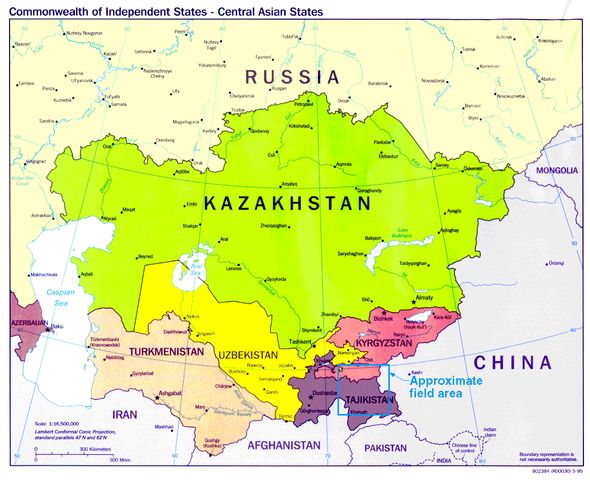LONDON (TCA) — May 22 is the date set for the final nod by the people of Tajikistan through a referendum to change the Constitution to allow the present head of state take part in presidential elections for as many terms as he wishes.
Tajikistan
The constitutional changes also include lowering the minimum age for a head of state from 35 to 30, thus allowing President Emomali Rahmon to put his now 27-year-old son forward as a candidate in the elections due for 2020. The move adds one more member to the “dynasty club” of post-Soviet states which according to critics diverts from the path towards democracy.
“Founder of peace and national unity” and “Leader of the Nation” are the flattering honors granted to Tajikistan’s President in office (since 1994) immortalizing his character – and securing his relatives’ position in the country’s state structures and economy. Thus, the President’s son, Rustam Emomali, already chairs the national anti-corruption committee.
There seems to be a pattern here, if the allegations are true. Rahmon’s daughter, Ozoda Rahmon, used to serve as head of the consular department of the Tajik Foreign Ministry and later first Deputy Foreign Minister, was appointed chief of the presidential administration on January 27 this year, the very day the Parliament approved the constitutional amendments. Her husband Jamoliddin Nuraliyev is the first deputy chairman of the central bank. Rahmon’s brother-in-law, Hasan Asadullozoda, controls Orienbank, one of the country’s largest lenders, and the TALCO aluminum plant which is the country’s largest employer after the state and its only major-scale industry to speak of. Virtually all Tajikistan’s oligarchs have direct or indirect relations with the presidential family: no intruders allowed.
Turkmenistan
The pompous laureates which could be seen as a modest heritage of those boasted in their days by the likes of Genguiz Khan and Tamerlan (“Lord of the Universe”) are in vogue in Central Asia. More recently, the Turkmen President Saparmurat Niyazov held the title Turkmenbashi (The Leader of All Turkmen) until his death in 2006. He has been an exception to the rule: instead of preparing the throne for his closest relative, he appointed his dentist as his successor shortly before he died. The country’s council of elders, acting as a sort of parliament, appeared to have approved the nomination. The new man in power, Gurbanguly Berdymukhammedov, is officially called Arkadag – the protector.
Kazakhstan
Kazakhstan’s head of state Nursultan Nazarbayev, in power since 1989, meaning well before the break-up of the USSR, has enjoyed immunity since 2000 and was designated Leader of the Nation in 2010, with indefinite rights to stand in elections. Much of his strategy to keep his family close to his side has not worked out as planned, however. His son-in-law Rakhat Aliyev, married to his elder daughter Dariga, first enriched himself with the appropriation of the state sugar import concession and one of the leading banks, Nurbank. Later, he became deputy head of the national security service which he used to eliminate numerous rivals – some of them physically. On the run since 2007, Aliyev was to end up hanging himself in a prison cell in Austria while awaiting trial.
The other son-in-law, Timur Kulibayev, married to the President’s youngest daughter Dinara, has been luckier: though he was stripped of all his state-related functions after a strike among oil workers in Zhanaozen in the southwest of Kazakhstan ended in a massacre, he still controls a wide range of enterprises and is considered the richest man in the country. As for Dariga, first a member of Parliament and since September last year Deputy Prime Minister, she is often tipped as successor to Nazarbayev.
Uzbekistan
In neighbouring Uzbekistan, a similar variety to Shakespeare’s Hamlet is being staged, with the eldest daughter of President Islam Karimov (like Nazarbayev, a former Soviet leader) and fashion queen Gulnara fallen out of grace and now living in exile in Switzerland while persecuted for misappropriation of state funds back home. Her younger sister Lola has been reportedly tipped as a candidate for succession to the head of state.
Kyrgyzstan
All this leaves Kyrgyzstan and its nation aside. Attempts by post-Soviet heads of state to take after their peers ruling neighbouring states failed twice: with the so-called Tulip Revolution in 2005 and with its follow-up five years later which brought the downfall of the clique surrounding President Kurmanbek Bakiyev about. The message from the people has been clear: no abusive autocrats in this place. Ever since, a parliamentary democracy has remained in place – unique in the region. Given the long history of the Kyrgyz nation, however, this should hardly come as a surprise.
By long tradition, the main difference between Kyrgyzstan and other Central-Asian newly independent states was that in contrast with e.g. Kazakhstan, Uzbekistan and Tajikistan, no all-Kyrgyz khan or other autocratic ruler had ever existed and no hierarchic system between tribal adherences had ever been in place in Kyrgyzstan. As a result, unsurprisingly, the struggle against corruption and extortion in Kyrgyzstan looks more effective and more indiscriminate than in other Central Asian former Soviet republics.
Autocratic regimes
The whole problem with “autocratic” regimes is not that the one-man show on top imposes all decisions and indeed all but the entire state policy. The problem is not so much the man (or eventually woman) on top but the echelons below him. They tend to consist mainly of people for whom loyalty is more important than competence. This tends to be an open invitation for abuse – a mechanism that sips down from the very top to the very bottom. In all, haloing heroic leaders may be in the people’s character, but it does not help them much.

